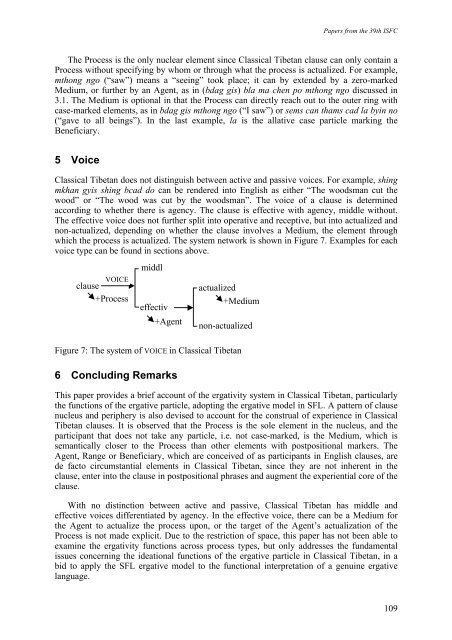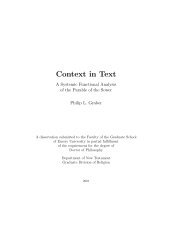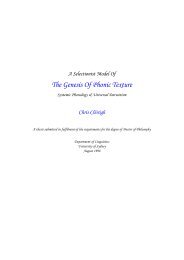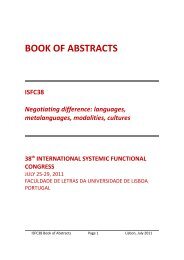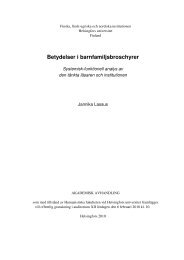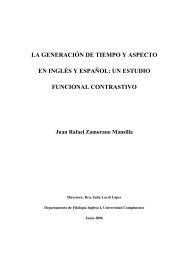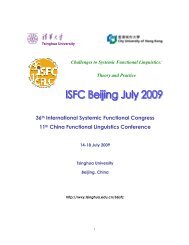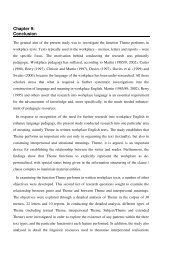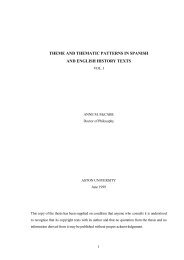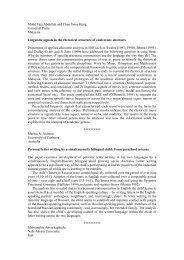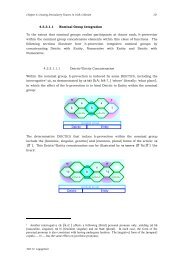the ISFC39 Proceedings - International Systemic-Functional ...
the ISFC39 Proceedings - International Systemic-Functional ...
the ISFC39 Proceedings - International Systemic-Functional ...
You also want an ePaper? Increase the reach of your titles
YUMPU automatically turns print PDFs into web optimized ePapers that Google loves.
Papers from <strong>the</strong> 39th ISFCThe Process is <strong>the</strong> only nuclear element since Classical Tibetan clause can only contain aProcess without specifying by whom or through what <strong>the</strong> process is actualized. For example,mthong ngo (“saw”) means a “seeing” took place; it can by extended by a zero-markedMedium, or fur<strong>the</strong>r by an Agent, as in (bdag gis) bla ma chen po mthong ngo discussed in3.1. The Medium is optional in that <strong>the</strong> Process can directly reach out to <strong>the</strong> outer ring withcase-marked elements, as in bdag gis mthong ngo (“I saw”) or sems can thams cad la byin no(“gave to all beings”). In <strong>the</strong> last example, la is <strong>the</strong> allative case particle marking <strong>the</strong>Beneficiary.5 VoiceClassical Tibetan does not distinguish between active and passive voices. For example, shingmkhan gyis shing bcad do can be rendered into English as ei<strong>the</strong>r “The woodsman cut <strong>the</strong>wood” or “The wood was cut by <strong>the</strong> woodsman”. The voice of a clause is determinedaccording to whe<strong>the</strong>r <strong>the</strong>re is agency. The clause is effective with agency, middle without.The effective voice does not fur<strong>the</strong>r split into operative and receptive, but into actualized andnon-actualized, depending on whe<strong>the</strong>r <strong>the</strong> clause involves a Medium, <strong>the</strong> element throughwhich <strong>the</strong> process is actualized. The system network is shown in Figure 7. Examples for eachvoice type can be found in sections above.clause VOICE+Processmiddleeffective+Agentactualized+Mediumnon-actualizedFigure 7: The system of VOICE in Classical Tibetan6 Concluding RemarksThis paper provides a brief account of <strong>the</strong> ergativity system in Classical Tibetan, particularly<strong>the</strong> functions of <strong>the</strong> ergative particle, adopting <strong>the</strong> ergative model in SFL. A pattern of clausenucleus and periphery is also devised to account for <strong>the</strong> construal of experience in ClassicalTibetan clauses. It is observed that <strong>the</strong> Process is <strong>the</strong> sole element in <strong>the</strong> nucleus, and <strong>the</strong>participant that does not take any particle, i.e. not case-marked, is <strong>the</strong> Medium, which issemantically closer to <strong>the</strong> Process than o<strong>the</strong>r elements with postpositional markers. TheAgent, Range or Beneficiary, which are conceived of as participants in English clauses, arede facto circumstantial elements in Classical Tibetan, since <strong>the</strong>y are not inherent in <strong>the</strong>clause, enter into <strong>the</strong> clause in postpositional phrases and augment <strong>the</strong> experiential core of <strong>the</strong>clause.With no distinction between active and passive, Classical Tibetan has middle andeffective voices differentiated by agency. In <strong>the</strong> effective voice, <strong>the</strong>re can be a Medium for<strong>the</strong> Agent to actualize <strong>the</strong> process upon, or <strong>the</strong> target of <strong>the</strong> Agent’s actualization of <strong>the</strong>Process is not made explicit. Due to <strong>the</strong> restriction of space, this paper has not been able toexamine <strong>the</strong> ergativity functions across process types, but only addresses <strong>the</strong> fundamentalissues concerning <strong>the</strong> ideational functions of <strong>the</strong> ergative particle in Classical Tibetan, in abid to apply <strong>the</strong> SFL ergative model to <strong>the</strong> functional interpretation of a genuine ergativelanguage.109


